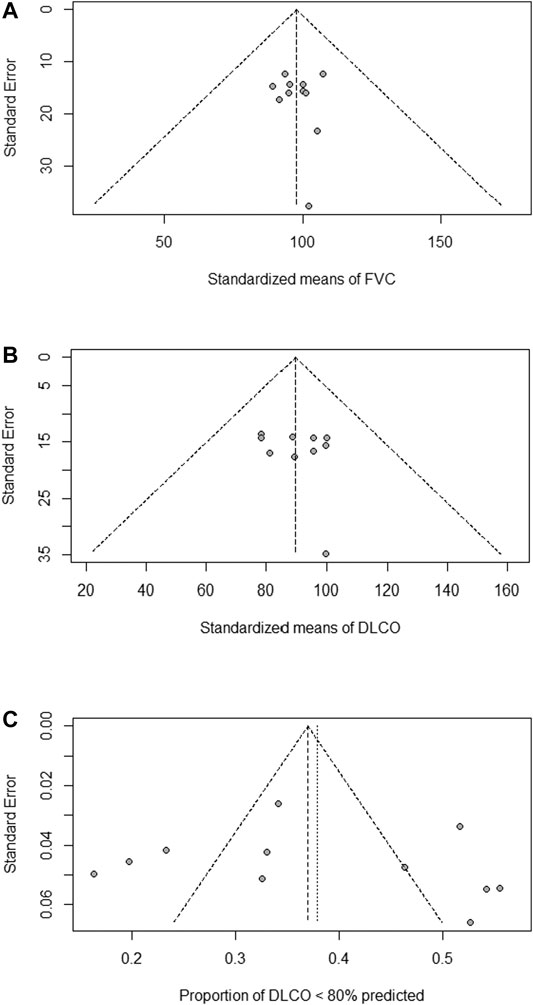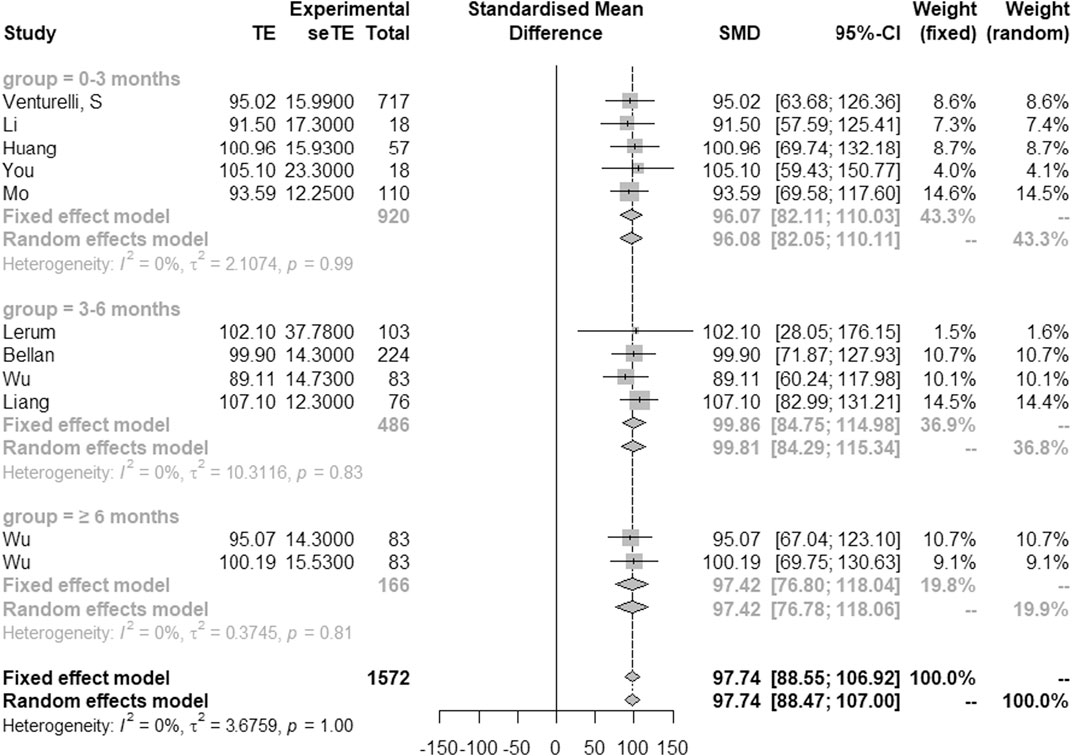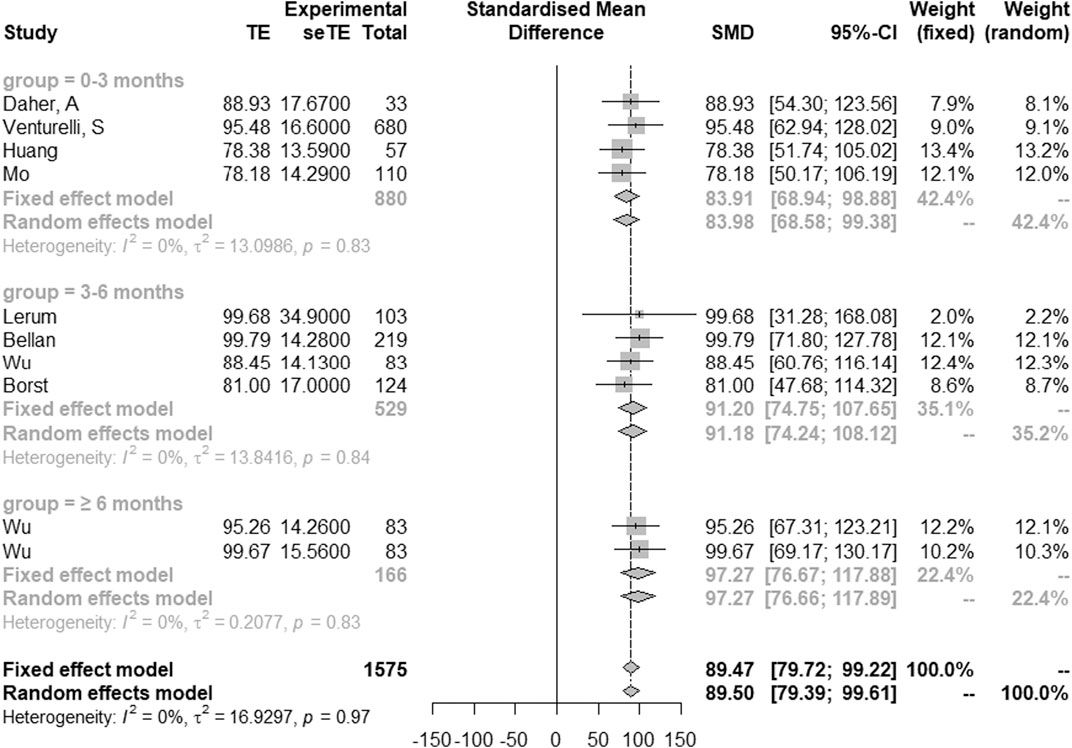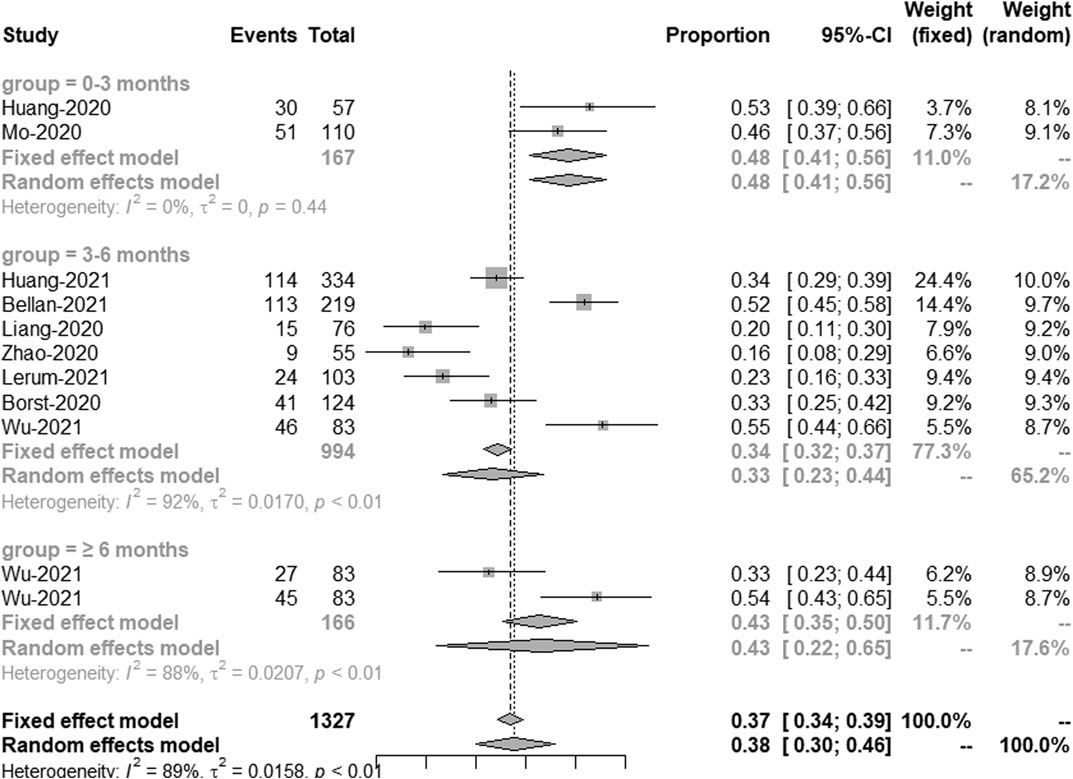
94% of researchers rate our articles as excellent or good
Learn more about the work of our research integrity team to safeguard the quality of each article we publish.
Find out more
ORIGINAL RESEARCH article
Front. Mol. Biosci., 06 October 2021
Sec. Molecular Diagnostics and Therapeutics
Volume 8 - 2021 | https://doi.org/10.3389/fmolb.2021.750558
This article is part of the Research TopicThe Upcoming Complications of COVID-19 on Recovered Patients: Molecular Mechanisms and Therapeutic OpportunitiesView all 13 articles
Background: To determine the respiratory outcomes in patients following COVID-19-related hospitalization.
Methods: Systematic review and meta-analysis of the literature.
Results: Forced vital capacity (FVC, % of predicted): 0–3 months post discharge: 96.1, 95% CI [82.1–110.0]; 3–6 months post discharge: 99.9, 95% CI [84.8, 115.0]; >6 months post discharge: 97.4, 95% CI [76.8–118.0]. Diffusing capacity of the lungs for carbon monoxide (DLCO, % of predicted): 0–3 months post discharge: 83.9, 95% CI [68.9–98.9]; 3–6 months post discharge: 91.2, 95% CI [74.8–107.7]; >6 months post discharge: 97.3, 95% CI [76.7–117.9]. Percentage of patients with FVC less than 80% of predicted: 0–3 months post discharge: 10%, 95% CI [6–14%]; 3–6 months post discharge: 10%, 95% CI [2–18%]; >6 months post discharge: 13%, 95% CI [8–18%]. Percentage of patients with DLCO less than 80% of predicted: 0–3 months post discharge: 48%, 95% CI [41–56%]; 3–6 months post discharge: 33%, 95% CI [23–44%]; >6 months post discharge: 43%, 95% CI [22–65%].
Conclusion: The meta-analysis confirms a high prevalence of persistent lung diffusion impairment in patients following COVID-19-related hospitalization. Routine respiratory follow-up is thus strongly recommended.
To date, over 200 million people worldwide have recovered from COVID-19 (https://www.worldometers.info/coronavirus/) (Worldometers (2020). Worl, 2020), but concern remains that some organs, including the lungs, might suffer long-term impairment following recovery from acute infections. Individual studies have shown that residual abnormalities of pulmonary function were observed in a subgroup of recovered COVID-19 patients, with the most common finding being a reduction in gas transfer as measured by diffusing capacity of the lungs for carbon monoxide (DLCO) (Hull et al., 2020; Dhawan et al., 2021; Thomas et al., 2021). In this study, with meta-analysis, we aimed to determine the short (0–3 months), medium (3–6 months) and long (>6 months) respiratory outcomes in patients following COVID-19-related hospitalisation. The findings will instruct appropriate interventions for subsequent increased healthcare utilisation post-COVID-19.
We included randomised controlled trials (RCTs) and observational studies (cross-sectional, longitudinal, case-control and cohort) of patients with a confirmed diagnosis of COVID-19. The studies included aimed to determine the respiratory outcomes, in particular forced vital capacity (FVC) and diffusing capacity of the lungs for carbon monoxide (DLCO), in patients following COVID-19-related hospitalisation. The selected studies had to follow the ATS / ERS clinical guidelines. The included literatures should be published before May 15, 2021.
Study’s subjects who were not infected with COVID-19. Studies didn’t report the time of hospital discharge or the time was calculated from diagnosis of COVID-19. Studies did not report FVC (% of predicted) or DLCO (% of predicted) or FVC <80% of predicted or DLCO <80% of predicted. Animal experiments, medical records, case reports, famous medical experience and review were excluded.
Firstly, according to the literature inclusion criteria, two researchers independently searched at Pubmed, ScienceDirect, Embase and Web of Science. Secondly, two researchers selected the literature and extracted the data independently in accordance with the standard data extraction table. When it came to divergences, a third researcher did the judgement. After the discussion, researchers reached a consensus. Finally, after the extraction and input of the data, two independent researchers did the subsequent analysis.
According to the inclusion criteria, we assessed the design of research, patients, and outcome indicators. First author, published year, number of cases, nationality, ages, body mass index (BMI), smoking status, respiratory comorbidities, time of assessment and, index quantity of FVC, % of predicted, DLCO, % of predicted; FVC <80% of predicted and DLCO <80% of predicted were extracted from eligible studies.
The studies with randomised controlled trials were evaluated by Newcastle-Ottawa Scale (Bellan et al., 2021). As for no controlled trials, it includes the following aspects: 1) selection: Representativeness of the exposed cohort, selection of the non-exposed cohort, Ascertainment of exposure, Demonstration that outcome of interest was not present at start of study; 2) comparability: Research control matched important factors, but also controlled other important factors; and 3) outcome: assessment of outcome, follow-up long enough for outcomes to occur, adequacy of follow up of cohorts.
We used package “meta (version 4.18-0)” in R 4.0.1 and R studio to perform meta-analysis of the following pulmonary function tests (PFTs) indexes (1. FVC, % of predicted; 2. DLCO, % of predicted; 3. FVC <80% of predicted; 4. DLCO <80% of predicted.). Patients were divided into three groups: less than 3 months (0–3 months), more than or equal to 3 months and less than 6 months (3–6 months), and more than or equal to 6 months (≥6 months). We re-calculated the median (first quantile, third quantile) to mean ± standard deviation (SD) for FVC (% of predicted) and DLCO (% of predicted) in several studies. Statistical heterogeneity was measured through the I2 statistic and classified as low (I2 < 25%), moderate (I2 25–50%), and high (I2 > 50%) (Melsen et al., 2014). Subgroup analysis, according to the outcome assessment and severity, was performed. Sensitivity analysis was also employed to assess the change in pooled prevalence due to the selective exclusion of studies.
A total of 1,123 articles was retrieved from databases via the retrieval methods. Duplicate literatures were excluded through titles and abstracts. By reading the full text, we excluded 1,110 papers and conference abstracts with incomplete or no specific research method. Finally, 13 papers published in English were included (Liang et al., 2020; Huang et al., 2020; Venturelli et al., 2021; You et al., 2020; Lerum et al., 2021; Daher et al., 2020; Wu et al., 2021; Bellan et al., 2021; Li et al., 2020; van den Borst et al., 2020; Mo et al., 2020; Zhao et al., 2020; Huang et al., 2021), with a total of 3,455 patients. The evaluation of the quality of included studies by Newcastle-Ottawa Scale (NOS) (Stang et al., 2018) showed that two studies had a poor quality and the rest 11 studies passed the quality control. The basic characteristics of the included literatures were detailed in Table 1 and the procedure of literature retrieval and selection was shown in Figure 1.
Among the included studies, 10 studies reported FVC (% of predicted), eight studies reported DLCO (% of predicted), six reported FVC <80% of predicted, and nine reported DLCO <80% of predicted. Wu et al. (2021). reported all the indexes of the patients after the 3, 6 and 12 months following COVID-19-related hospitalisation (Table 2). For those data reported in the form of median (first quantile, third quantile), we used R studio to re-calculate them into mean ± SD (Table 3).
Publication bias refers to the fact that research results with statistical significance are more likely to be reported and published than those without statistical significance and invalid results (DeVito and Goldacre, 2019). We examined the publication bias of meta-analysis of each indicator. There was no publication bias in FVC (% of predicted; p = 0.93; Figure 2A), DLCO (% of predicted; p = 0.54; Figure 2B) and DLCO (<80% of predicted; p = 0.94; Figure 2C). For FVC <80% of predicted, less than 10 studies were included, so publication bias was not tested.

FIGURE 2. No publication bias of the meta-analysis. Funnel plots of FVC (% of predicted) (A), DLCO (% of predicted) (B) and DLCO <80% of predicted (C) were shown. Each dot represents a study.
Nine studies with 11 groups of data showed the results of FVC (% of predicted). Based on the time of patients discharged from hospital, we divided them into three groups: 0–3 months, 3–6 months and ≥6 months. FVC (% of predicted) in 0–3 months, 3–6 months and ≥6 months post discharge were 96.1 (95% CI [82.1–110.0]), 99.9 (95% CI [84.8–115.0]) and 97.4 (95% CI [76.8–118.0]), respectively. In this study, heterogeneity was extremely low (I2 = 0%), and the overall value of FVC (% of predicted) in all studies was 97.7 (95% CI [88.6–106.9]) (Figure 3).

FIGURE 3. Comparison of longitudinal changes in FVC (% of predicted). Forest plot showing meta-analysis of FVC (% of predicted).
Eight studies with 10 groups of data showed the results of DLCO (% of predicted). DLCO (% of predicted) in 0–3 months, 3–6 months and ≥6 months post discharge were 83.9 (95% CI [68.9–98.9]), 91.2 (95% CI [74.8–107.7]) and 97.3 (95% CI [76.7–117.9]), respectively. Heterogeneity was considered low (I2 = 0%) using a fixed effect model (Melsen et al., 2014; Bellou et al., 2016) (Figure 4).

FIGURE 4. Comparison of longitudinal changes in DLCO (% of predicted). Forest plot showing meta-analysis of DLCO (% of predicted).
Comparison of longitudinal changes in the percentage of patients with FVC <80% of predicted.
These included six studies, which in total have eight groups of data showed the percentage of patients with FVC less than 80% of predicted. Based on the time of patients being discharged from hospital, we divided them into three groups: 0–3 months, 3–6 months and greater than 6 months. Meta-analysis showed that the percentage of patients with FVC less than 80% of predicted in 0–3 months, 3–6 months and ≥6 months post discharge was 10% (95% CI [6–14%]), 10% (95% CI [2–18%]) and 13% (95% CI [8–18%], respectively. The heterogeneity of 3–6 months was large, so the sensitivity analysis was carried out in this study. We removed the study from Wu et al. and got the meta-analysis result of this subgroup, which was 4% (95% CI [3–6%]) with I2 = 6% (Figure 5).

FIGURE 5. Comparison of longitudinal changes in the percentage of patients with FVC <80% of predicted. Forest plot showing meta-analysis of the percentage of patients with FVC <80% of predicted.
Comparison of longitudinal changes in the percentage of patients with DLCO <80% of predicted.
This included nine studies, which have 11 groups of data shows the results of DLCO less than 80% of predicted. Meta-analysis showed a significant and persistent reduction in DLCO over the study period. The percentage of patients with DLCO less than 80% of predicted in 0–3 months, 3–6 months and ≥6 months post discharge was 48% (95% CI [41–56%]), 33% (95% CI [23–44%]) and 43% (95% CI [22–65%]), respectively (Figure 6).

FIGURE 6. Comparison of longitudinal changes in the percentage of patients with DLCO <80% of predicted. Forest plot showing meta-analysis of the percentage of patients with DLCO <80% of predicted.
Post-acute COVID-19 syndrome, also known as long COVID, encompasses a wide range of physical and mental health symptoms that persist after recovery from acute SARS-CoV-2 infections (Nalbandian et al., 2021). Systematic studies of sequelae after recovery from acute COVID-19 are demanded to inform effective clinical management for patients suffered from long COVID.
We recently reported the 3 months, 6 months, 9 months, and 12 months respiratory outcomes in patients following COVID-19-related hospitalisation from a relatively small prospective cohort (n = 83) (Wu et al., 2021). In this study, we conducted meta-analysis to determine the short (0–3 months), medium (3–6 months) and long (>6 months) respiratory outcomes in patients following COVID-19-related hospitalisation. Significantly, we found a persistent reduction in DLCO over the study period, consistent with earlier reports (E et al., 2021). Low DLCO could be caused by interstitial changes or pulmonary vascular abnormalities following COVID-19 infections (Lang et al., 2020; Patel et al., 2020; Hanidziar and Robson, 2021). Our study has shown that up to a third of COVID patients still have evidence of defect DLCO 1 year after discharge (Wu et al., 2021), although longer term follow-up with a larger cohort will be required to confirm this observation.
In general, the heterogeneity of the studies included in the meta-analysis was low. However, the heterogeneity of DLCO less than 80% of predicted was higher, which may be caused by different ethnic groups, ages, disease severity, therapies and other factors. In general, the models we used were robust and reliable.
There are several limitations in this study. Firstly, age, sex ratio, nationality and disease severity of the patients included in the study are quite different, which may cause great heterogeneity and affect the final research results. Secondly, we only selected four indicators of lung function, so we cannot investigate the relationship between other indicators and discharge time. To be consistent and comparable with our earlier publication (Wu et al., 2021), we excluded those studies without data on FVC and/or DLCO values <80% of predicted. This might cause some false positive results considering the mean age of included patients is over 50 (van den Borst et al., 2020; Barisione and Brusasco, 2021; Milanese et al., 2021). In addition, pre-existing comorbidities for most COVID-19 patients are not known, which might cause certain bias of the results. Despite of these limitations, our findings in this meta-analysis are consistent with our previous report (Wu et al., 2021), confirming a high prevalence of persistent lung diffusion impairment in patients following COVID-19-related hospitalisation. Routine respiratory follow-up is thus strongly recommended.
The original contributions presented in the study are included in the article/Supplementary Material, further inquiries can be directed to the corresponding author.
YW conceived and designed the study. TG, FJ, YL, YZ and YL collected the data. TG and FJ performed the data analysis. TG and YL did the evaluation of the quality of included articles. TG and YW wrote the article. All authors are responsible for reviewing data. All authors read and approved the final article.
YW was supported by Medical Research Council (United Kingdom) (MR/S025480/1).
The authors declare that the research was conducted in the absence of any commercial or financial relationships that could be construed as a potential conflict of interest.
All claims expressed in this article are solely those of the authors and do not necessarily represent those of their affiliated organizations, or those of the publisher, the editors, and the reviewers. Any product that may be evaluated in this article, or claim that may be made by its manufacturer, is not guaranteed or endorsed by the publisher.
BMI, body mass index; COVID-19, Corona virus disease 2019; DLCO, diffusing capacity for carbon monoxide; FVC, forced vital capacity; NR, not reported; PFTs, pulmonary function tests.
Barisione, G., and Brusasco, V. (2021). Lung diffusing capacity for nitric oxide and carbon monoxide following mild-to-severe COVID-19. Physiol. Rep. 9 (4), e14748. doi:10.14814/phy2.14748
Bellan, M., Soddu, D., Balbo, P. E., Baricich, A., Zeppegno, P., Avanzi, G. C., et al. (2021). Respiratory and Psychophysical Sequelae Among Patients With COVID-19 Four Months after Hospital Discharge. JAMA Netw. Open 4 (1), e2036142. doi:10.1001/jamanetworkopen.2020.36142
Bellou, V., Belbasis, L., Tzoulaki, I., Evangelou, E., and Ioannidis, J. P. A. (2016). Environmental risk factors and Parkinson's disease: An umbrella review of meta-analyses. Parkinsonism Relat. Disord. 23, 1–9. doi:10.1016/j.parkreldis.2015.12.008
Daher, A., Balfanz, P., Cornelissen, C., Müller, A., Bergs, I., Marx, N., et al. (2020). Follow up of patients with severe coronavirus disease 2019 (COVID-19): Pulmonary and extrapulmonary disease sequelae. Respir. Med. 174, 106197. doi:10.1016/j.rmed.2020.106197
DeVito, N. J., and Goldacre, B. (2019). Catalogue of bias: publication bias. Bmj Ebm 24 (2), 53–54. doi:10.1136/bmjebm-2018-111107
Dhawan, R. T., Gopalan, D., Howard, L., Vicente, A., Park, M., Manalan, K., et al. (2021). Beyond the clot: perfusion imaging of the pulmonary vasculature after COVID-19. Lancet Respir. Med. 9 (1), 107–116. doi:10.1016/s2213-2600(20)30407-0
Ekbom, E., Frithiof, R., Emilsson, Öi., Larson, I.M., Lipcsey, M., Rubertsson, S., et al. (2021). Impaired diffusing capacity for carbon monoxide is common in critically ill Covid-19 patients at four months post-discharge. Respir. Med. 182, 106394. doi:10.1016/j.rmed.2021.106394
Hanidziar, D., and Robson, S. C. (2021). Hyperoxia and modulation of pulmonary vascular and immune responses in COVID-19. Am. J. Physiology-Lung Cell Mol. Physiol. 320 (1), L12–L16. doi:10.1152/ajplung.00304.2020
Huang, C., Huang, L., Wang, Y., Li, X., Ren, L., Gu, X., et al. (2021). 6-month consequences of COVID-19 in patients discharged from hospital: a cohort study. The Lancet 397 (10270), 220–232. doi:10.1016/s0140-6736(20)32656-8
Huang, Y., Tan, C., Wu, J., Chen, M., Wang, Z., Luo, L., et al. (2020). Impact of coronavirus disease 2019 on pulmonary function in early convalescence phase. Respir. Res. 21 (1), 163. doi:10.1186/s12931-020-01429-6
Hull, J. H., Lloyd, J. K., and Cooper, B. G. (2020). Lung function testing in the COVID-19 endemic. Lancet Respir. Med. 8 (7), 666–667. doi:10.1016/s2213-2600(20)30246-0
Lang, M., Som, A., Mendoza, D. P., Flores, E. J., Reid, N., Carey, D., et al. (2020). Hypoxaemia related to COVID-19: vascular and perfusion abnormalities on dual-energy CT. Lancet Infect. Dis. 20 (12), 1365–1366. doi:10.1016/s1473-3099(20)30367-4
Lerum, T. V., Aaløkken, T. M., Brønstad, E., Aarli, B., Ikdahl, E., Lund, K. M. A., et al. (2021). Dyspnoea, lung function and CT findings 3 months after hospital admission for COVID-19. Eur. Respir. J. 57 (4), 2003448. doi:10.1183/13993003.03448-2020
Li, X., Wang, C., Kou, S., Luo, P., Zhao, M., and Yu, K. (2020). Lung ventilation function characteristics of survivors from severe COVID-19: a prospective study. Crit. Care 24 (1), 300. doi:10.1186/s13054-020-02992-6
Liang, L., Yang, B., Jiang, N., Fu, W., He, X., Zhou, Y., et al. (2020). Three-month Follow-up Study of Survivors of Coronavirus Disease 2019 after Discharge. J. Korean Med. Sci. 35 (47), e418. doi:10.3346/jkms.2020.35.e418
Melsen, W. G., Bootsma, M. C. J., Rovers, M. M., and Bonten, M. J. M. (2014). The effects of clinical and statistical heterogeneity on the predictive values of results from meta-analyses. Clin. Microbiol. Infect. 20 (2), 123–129. doi:10.1111/1469-0691.12494
Milanese, M., Anselmo, M., Buscaglia, S., Garra, L., Goretti, R., Parodi, L., et al. (2021). COVID-19 6 months after hospital discharge: pulmonary function impairment and its heterogeneity. ERJ Open Res. 7 (3), 00196–02021. doi:10.1183/23120541.00196-2021
Mo, X., Jian, W., Su, Z., Chen, M., Peng, H., Peng, P., et al. (2020). Abnormal pulmonary function in COVID-19 patients at time of hospital discharge. Eur. Respir. J. 55 (6), 2001217. doi:10.1183/13993003.01217-2020
Nalbandian, A., Sehgal, K., Gupta, A., Madhavan, M. V., McGroder, C., Stevens, J. S., et al. (2021). Post-acute COVID-19 syndrome. Nat. Med. 27 (4), 601–615. doi:10.1038/s41591-021-01283-z
Patel, B. V., Arachchillage, D. J., Ridge, C. A., Bianchi, P., Doyle, J. F., Garfield, B., et al. (2020). Pulmonary Angiopathy in Severe COVID-19: Physiologic, Imaging, and Hematologic Observations. Am. J. Respir. Crit. Care Med. 202 (5), 690–699. doi:10.1164/rccm.202004-1412oc
Stang, A., Jonas, S., and Poole, C. (2018). Case study in major quotation errors: a critical commentary on the Newcastle-Ottawa scale. Eur. J. Epidemiol. 33 (11), 1025–1031. doi:10.1007/s10654-018-0443-3
Thomas, M., Price, O. J., and Hull, J. H. (2021). Pulmonary function and COVID-19. Curr. Opin. Physiol. 21, 29–35. doi:10.1016/j.cophys.2021.03.005
van den Borst, B., Peters, J. B., and Brink, M. (2020). Comprehensive health assessment three months after recovery from acute COVID-19. Clin. Infect. Dis. doi:10.1093/cid/ciaa1750
Venturelli, S., Benatti, S. V., Casati, M., Binda, F., Zuglian, G., Imeri, G., et al. (2021). Surviving COVID-19 in Bergamo province: a post-acute outpatient re-evaluation. Epidemiol. Infect. 149, e32. doi:10.1017/s0950268821000145
Worldometers (2020). World Meter Corona Virus Update. (Live) Available from https://www.worldometers.info/coronavirus/.
Wu, X., Liu, X., Zhou, Y., Yu, H., Li, R., Zhan, Q., et al. (2021). 3-month, 6-month, 9-month, and 12-month respiratory outcomes in patients following COVID-19-related hospitalisation: a prospective study. Lancet Respir. Med. 9 (7), 747–754. doi:10.1016/S2213-2600(21)00174-0
You, J., Zhang, L., Ni-Jia-Ti, M.-y. -d. -l., Zhang, J., Hu, F., Chen, L., et al. (2020). Anormal pulmonary function and residual CT abnormalities in rehabilitating COVID-19 patients after discharge. J. Infect. 81 (2), e150–e152. doi:10.1016/j.jinf.2020.06.003
Keywords: COVID-19, follow-up, pulmonary function test, FVC, DLCO, synthesis review, meta-analysis
Citation: Guo T, Jiang F, Liu Y, Zhao Y, Li Y and Wang Y (2021) Respiratory Outcomes in Patients Following COVID-19-Related Hospitalization: A Meta-Analysis. Front. Mol. Biosci. 8:750558. doi: 10.3389/fmolb.2021.750558
Received: 30 July 2021; Accepted: 07 September 2021;
Published: 06 October 2021.
Edited by:
Rana Jahanban-Esfahlan, Tabriz University of Medical Sciences, IranReviewed by:
Doaa El Amrousy, Faculty of Medicine, Tanta University, EgyptCopyright © 2021 Guo, Jiang, Liu, Zhao, Li and Wang. This is an open-access article distributed under the terms of the Creative Commons Attribution License (CC BY). The use, distribution or reproduction in other forums is permitted, provided the original author(s) and the copyright owner(s) are credited and that the original publication in this journal is cited, in accordance with accepted academic practice. No use, distribution or reproduction is permitted which does not comply with these terms.
*Correspondence: Yihua Wang, eWlodWEud2FuZ0Bzb3Rvbi5hYy51aw==
Disclaimer: All claims expressed in this article are solely those of the authors and do not necessarily represent those of their affiliated organizations, or those of the publisher, the editors and the reviewers. Any product that may be evaluated in this article or claim that may be made by its manufacturer is not guaranteed or endorsed by the publisher.
Research integrity at Frontiers

Learn more about the work of our research integrity team to safeguard the quality of each article we publish.